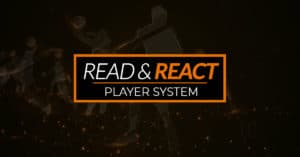I’ve been asked from time to time to compare the Dribble Drive Motion Offense to the Read & React Offense. In order to make a fair comparison, a person should view the DVDs of both offenses, watch teams that run the offenses in real games, and talk to coaches who are sold on each offense. I’ve done all three, which might make me uniquely qualified to make the comparison.
Admittedly, as the creator of the Read & React Offense, I bring a bias to the table. This bias might be a factor if we were comparing two offenses that were both 4 OUT 1 IN sets with an emphasis on creating dribble drive opportunities, but since the comparison is really “apples vs oranges”, my bias shouldn’t enter the equation.
I would never attempt to speak for Coach Walberg (the creator of the Dribble Drive Attack – which he prefers in place of Dribble Drive Motion). If you want to know his offense, along with the big picture and philosophy behind it, do like I did – watch his DVDs.
Without any hesitation, I can say that I appreciate the problems that Coach Walberg was trying to fix when he created the DDA:
- How to allow players to take advantage of their dribble-drive-attacking skills without using set plays.
- How to draw upon the creativity of players (making it fun for them) and yet maximize their options if the defense stops their initial action.
- How to get the best spacing in a 4 OUT 1 IN set.
There’s more to the DDA than I can sum up in a single paragraph, so we should look at the bottom line: Does it work?
Of course it does! The proof is in the pudding; there are lots of teams that are successful using the DDA.
So what’s the difference between the Read & React (R&R) and the Dribble Drive Attack (DDA)?
The best way to answer this question is by looking at why and for what each offense was created.
Coach Walberg mentions on his DVD that the DDA is not for everyone.
Why not?
Because all teams do not meet the criteria that Coach Walberg says is needed for the DDA to be successful. To name a few:
- You need two guards that can dribble-drive first and shoot second.
- You need two wings that can shoot first and dribble-drive second.
- Your post needs to be fast and agile.
- It demands an up-tempo style of play.
The DDA has additional positives (addressed later), but let me conclude this initial point of comparison this way: The DDA is AN offense, just like FLEX is AN offense, and it’s made for certain types of players and a certain style of play.
The R&R, on the other hand, does not require specific types of players, does not have a particular formation, and does not force a specific style of play.
The Main Differences
- The biggest difference is that the Read and React was created to be a developmental offense. It is taught in layers, but mastery of the whole is not essential for success. Many teams (especially youth teams) form a working offense with only the first three layers. Other teams, depending on their level of expertise, use the first five layers, while others use combinations. And those at the top levels will master all layers.
- Five-player coordination is accomplished in the DDA by teaching all 5 players simultaneously. The R&R five-player coordination is taught with 2-player-reads-and-reactions. This means that the drills used for the R&R are not simply applied to the offense, they are the offense!
- The drills for the DDA are used to acquire the skills that make the DDA successful (dribble penetration, lay-ups, etc). The R&R drills teach the offense and fundamental basketball skills at the same time. This was intentional on my part: a coach can collapse time frames, ultimately building the offense while at the same time sharpening his or her player’s skills.
- The R&R allows for flexibility of formation and style of play. Some examples would be:
- 5 OUT “open post” offense that emphasizes dribble drives only.
- 5 OUT pass and cut (like a passing game).
- 5 OUT multiple screens (for great catch-and-shoot players).
- 4 OUT 1 IN that takes the ball inside first to a strong Post Player.
- 4 OUT 1 IN post away and emphasizes dribble-drives.
- 4 OUT 1 IN with the post as a blocker (like a blocker-mover offense).
- 3 OUT 2 IN dribble drive emphasis.
- 3 OUT 2 IN strong post or post-screening-post play.
- 3 OUT 2 IN blocker mover.
- 3 OUT 2 IN high post pass and cut (think UCLA high post game).
4 OUT 1 IN with the post on the weak-side and an emphasis on dribble-drives is one of the formations that can be accomplished with the R&R.
If I had 4 perimeter players with good dribble-drive-attacking skills and if my 5th player was not a true back-to-the-basket post player, then I would run a 4 OUT set with my post player away from the ball. In this configuration it would take an expert to tell the difference between the R&R and the DDA!
In other words, the R&R can be set up to imitate the DDA, but not the other way around.
Two more differences worth mentioning are:
- The R&R can be run “behind” a set play or a quick hitter. Ultimately, if your quick hitter doesn’t work, then the players can flow directly into R&R and continue to attack with 5-player coordination.
- The R&R can be used as your zone offense. There’s no need to have separate man-to-man and zone offenses.
As you can see, to compare the R&R and DDA is unfair and difficult.
The R&R was created to be a progressive teaching program that would result in a team having the ability to play with any style, set, or type of players capable of attacking either zones or man-to-man defenses.
The DDA was created for a specific purpose: to attack man-to-man defenses with 4 dribble-attack perimeter players and a weak-side post.
Similarities
Coach Walberg first called his offense AASAA, which stood for Attack-Attack-Skip-Attack-Attack. I love that name because of the teaching emphasis. You’ll find something similar in the R&R when you view the Pin & Skip layer. The skip pass is taught as a “counter” against helping, sagging man-to-man defense or the weak-side of a zone. I added the Pin Screen to lengthen the defensive recovery time to the skip pass and create an inside threat at the same time.
Coach Walberg’s use of “The Drag” gives the penetrator the same option as the R&R’s Circle Movement Safety Valve. However, the R&R creates a Safety Valve for penetrators from any spot on the floor in any formation. If R&R were using a 4 OUT set, the differences would be hard to spot.
In the R&R, by Speed Dribbling or “Dribbling-At” at another perimeter player, the ball handler can force a rear cut. In the same vein, the ball handler can create a Pick & Roll handoff by Power Dribbling at another perimeter player. These two actions are true regardless of which perimeter player “dribbles at” whichever other perimeter player.
The DDA can create two similar actions, but each is dictated by which player is dribbling and which player is being “dribbled at.” For example, when a guard in the DDA dribbles at a wing, the wing rear cuts. When a guard “dribbles at” the other guard, (#1 dribbles toward #2), then #2 circles behind the ball. Regardless of the offense, I like “dribble-at-force-a-rear-cut” because of the pressure it puts on the rim.
In the R&R, I point out “Intelligent Drive” situations; how to read them and how to create them. Similarly, Coach Walberg does a great job with this idea by teaching Single Gap, Double Gap, and Triple Gap as a means to help players recognize Good Drives, Better Drives, and the Best Drives.
Exactly the Same
Characteristics of the Dribble Drive Attack that are exactly the same as the Read & React:
- It’s player friendly. It cuts to the natural instincts of the players.
- Good offense = good spacing and good spacing = good offense.
- It invites an attacking mentality.
- It uses the Skip Pass to counter sagging, helping defenders.
- 5-player coordination is accomplished without a “set play.”
- The idea of consistent predictable “windows” for passes by penetrators.
- The idea of creating and teaching “Intelligent Drives”.
- The attempt to create “Flow”; no resetting; constant probing/attacking.
Concluding Thoughts
1. The similarities between R&R and DDA arise out of a desire to attack the same problem: how to teach players to play instead of how to run plays.
2. The differences are seen when you consider what the two were created for: Coach Walberg solves the above problem with a 4 OUT 1 IN set and an emphasis on attacking with dribble penetration.
The Read & React Offense was created to solve the problem with any given formation, style of play, or type of players. It leaves it up to the individual coach to determine what formation, style of play, and points of emphasis are best for his/her team.
3. Basketball Offense has certain postulates like (this only names a few):
- spacing
- ball movement
- player movement
- an inside threat
- an outside threat
- a dribble penetration threat
- screening actions
- rebounding strategy
Any offense that has ever been successful was built around some of these postulates.
The Read & React does not simply “tip its hat” to these postulates. Nor does it simply try to incorporate a few of these. The Read & React is my attempt to get at the heart of offense – to deal directly with all the underlying fundamentals that make for good offense.
The Read & React is my effort to define, teach, develop, and link these foundational principles into a teachable and transferable system. This is why I say the Read & React is not an offense; the Read & React is offense.






